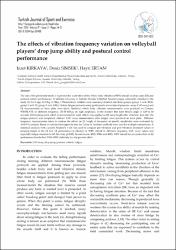| dc.contributor.author | Kırkaya, Izzet | |
| dc.contributor.author | Sımsek, Deniz | |
| dc.contributor.author | Ertan, Hayri | |
| dc.date.accessioned | 2019-10-22T20:06:49Z | |
| dc.date.available | 2019-10-22T20:06:49Z | |
| dc.date.issued | 2015 | |
| dc.identifier.uri | http://www.trdizin.gov.tr/publication/paper/detail/TVRreE5qVTFOUT09 | |
| dc.identifier.uri | https://hdl.handle.net/11421/22066 | |
| dc.description.abstract | The aim of the performed study is to present the acute effect of the whole body vibration (WBV) stimuli on drop jump (DJ) and postural control performance. 13 athletes who play in Turkish Women Volleyball Second League voluntarily attended to the study (22.3+-2.6 age; 60.72kg +-1.74kg; 1.79cm+-6.4cm). Athletes were randomly divided into three groups (group 1: n=4: 30Hz; group 2: n=5: 35; group 3: n=4: 40Hz). Before fatigue protocol, every participant's rest center of pressure- sway (CoP-sway) and DJ measurements on force plate were taken. Statistical whole body vibration measurements were practiced on Compex WINPLATE on different frequency (30-35-40Hz), on high amplitude, in the manner that knee flexion angle is 1200 in 60 seconds. DJ breaking point which is determined for each athlete was applied as DJ jump height after vibration. Just after the fatigue protocol was completed, athletes' CoP- sway measurements after fatigue were practiced on force plate. Different frequency measurements taken to analyse the effects on DJ height of frequency at specific amplitudes were evaluated by ANOVA analysis. Based on variance homogeneity test, the Tukey or Tamhane methods were used for multiple comparisons. A statistical analysis with a paired Student's t test was used to compare pre-vibration and post-vibration treatment values of jumping height at the DJ test. DJ performance is affected by WBV stimuli in different frequency, CoP- sway values and especially fatigue situation in AP direction (p>0.05). In conclusion, 30Hz-35Hz and 40Hz WBV stimuli has an acute effect on DJ performance beside that 35 Hz WBV definitely has the greatest effect. | en_US |
| dc.description.abstract | The aim of the performed study is to present the acute effect of the whole body vibration (WBV) stimuli on drop jump (DJ) and postural control performance. 13 athletes who play in Turkish Women Volleyball Second League voluntarily attended to the study (22.3+-2.6 age; 60.72kg +-1.74kg; 1.79cm+-6.4cm). Athletes were randomly divided into three groups (group 1: n=4: 30Hz; group 2: n=5: 35; group 3: n=4: 40Hz). Before fatigue protocol, every participant's rest center of pressure- sway (CoP-sway) and DJ measurements on force plate were taken. Statistical whole body vibration measurements were practiced on Compex WINPLATE on different frequency (30-35-40Hz), on high amplitude, in the manner that knee flexion angle is 1200 in 60 seconds. DJ breaking point which is determined for each athlete was applied as DJ jump height after vibration. Just after the fatigue protocol was completed, athletes' CoP- sway measurements after fatigue were practiced on force plate. Different frequency measurements taken to analyse the effects on DJ height of frequency at specific amplitudes were evaluated by ANOVA analysis. Based on variance homogeneity test, the Tukey or Tamhane methods were used for multiple comparisons. A statistical analysis with a paired Student's t test was used to compare pre-vibration and post-vibration treatment values of jumping height at the DJ test. DJ performance is affected by WBV stimuli in different frequency, CoP- sway values and especially fatigue situation in AP direction (p>0.05). In conclusion, 30Hz-35Hz and 40Hz WBV stimuli has an acute effect on DJ performance beside that 35 Hz WBV definitely has the greatest effect. | en_US |
| dc.language.iso | eng | en_US |
| dc.rights | info:eu-repo/semantics/openAccess | en_US |
| dc.subject | Sosyal Bilimler Tarihi | en_US |
| dc.title | The effects of vibration frequency variation on volleyball players' drop jump ability and postural control performance | en_US |
| dc.type | article | en_US |
| dc.relation.journal | Türk Spor ve Egzersiz Dergisi | en_US |
| dc.contributor.department | Anadolu Üniversitesi, Sağlık Bilimleri Enstitüsü, Beden Eğitimi ve Spor Anabilim Dalı | en_US |
| dc.identifier.volume | 17 | en_US |
| dc.identifier.issue | 2 | en_US |
| dc.identifier.startpage | 14 | en_US |
| dc.identifier.endpage | 21 | en_US |
| dc.relation.publicationcategory | Makale - Ulusal Hakemli Dergi - Kurum Öğretim Elemanı | en_US] |


















